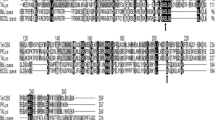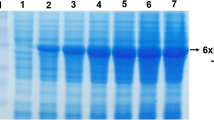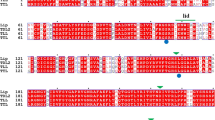Abstract
A thermoalkaliphilic T1 lipase gene of Geobacillus sp. strain T1 was overexpressed in pGEX vector in the prokaryotic system. Removal of the signal peptide improved protein solubility and promoted the binding of GST moiety to the glutathione-Sepharose column. High-yield purification of T1 lipase was achieved through two-step affinity chromatography with a final specific activity and yield of 958.2 U/mg and 51.5%, respectively. The molecular mass of T1 lipase was determined to be approximately 43 kDa by gel filtration chromatography. T1 lipase had an optimum temperature and pH of 70°C and pH 9, respectively. It was stable up to 65°C with a half-life of 5 h 15 min at pH 9. It was stable in the presence of 1 mM metal ions Na+, Ca2+, Mn2+, K+ and Mg2+ , but inhibited by Cu2+, Fe3+ and Zn2+. Tween 80 significantly enhanced T1 lipase activity. T1 lipase was active towards medium to long chain triacylglycerols (C10–C14) and various natural oils with a marked preference for trilaurin (C12) (triacylglycerol) and sunflower oil (natural oil). Serine and aspartate residues were involved in catalysis, as its activity was strongly inhibited by 5 mM PMSF and 1 mM Pepstatin. The T m for T1 lipase was around 72.2°C, as revealed by denatured protein analysis of CD spectra.






Similar content being viewed by others
References
Becker P, Reesh IA, Markossian S, Antranikian G, Märkl H (1997) Determination of the kinetic parameters during continuous cultivation of the lipase-producing thermophile Bacillus sp. IHI-91 on olive oil. Appl Microbiol Biotechnol 48:184–190
Brockman HW, Mornsen WE, Tsuijita T (1988) The biology, biochemistry and technology of lipases. J Am Oil Chem Soc 65:891–896
Cho AR, Yoo SK, Kim EJ (2000) Cloning, sequencing and expression in Escherichia coli of a thermophilic lipase from Bacillus thermoleovorans ID-1. FEMS Microbiol Lett 179:235–238
Choi WC, Kim MH, Ro HS, Ryu SR, Oh TK, Lee JK (2005) Zinc in lipase L1 from Geobacillus stearothermophilus L1 and structural implications on thermal stability. FEBS Lett 579:3461–3466
Coolbear T, Daniel RM, Morgan HW (1992) The enzyme from extreme thermophiles: bacterial sources, thermostabilities and industrial relevance. Adv Biochem Eng Biotechnol 45:57–59
Gao XG, Cao SG, Zhang KC (2000) Production, properties and application to nonaqueous enzymatic catalysis of lipase from a newly isolated Pseudomonas strain. Enzyme Microb Technol 27:74–82
Georgiou G (1996) Expression of protein in bacteria. In: Cleland JL, Craik CS (eds) Protein engineering. Wiley, New York, pp 101–128
Glusker JP, Katz AK, Bock CW (1999) Metal ions in biological systems. Rigaku J 16(2):8–16
Jeong ST, Kim HK, Kim SJ, Chi SW, Pan JG, Oh TK, Ryu SE (2002) Novel zinc-binding center and a temperature switch in the Bacillus stearothermophilus L1 lipase. J Biol Chem 277(19):17041–17047
Kim HK, Park SY, Lee JK, Oh TK (1998) Gene cloning and characterization of thermostable lipase from Bacillus stearothermophilus L1. Biosci Biotechnol Biochem 62:66–71
Kwon DK, Rhee JS (1986) A simple and rapid colorimetric method for determination of free fatty acids for lipase assay. J Am Oil Chem Soc 63:89–92
Laemmli UK (1970) Most commonly used discontinuous buffer system for SDS electrophoresis. Nature 227:680–686
Leow TC, Rahman RNZRA, Basri M, Salleh AB (2004) High level expression of thermostable lipase from Geobacillus sp. strain T1. Biosci Biotechnol Biochem 68(1):96–103
Li H, Zhang X (2005) Characterization of thermostable lipase from thermophilic Geobacillus sp. TW1. Protein Exp Purif 42(1):153–159
Lllanes A (1999) Stability of biocatalysis. Electron J Biotechnol 2(1):1–9
Nthangeni MB, Patterton HG, Tonder AV, Vergeer WP, Litthauer D (2001) Over-expression and properties of a purified recombinant Bacillus licheniformis lipase: a comparative report on Bacillus lipases. Enzyme Microb Technol 28:705–712
Sambrook J, Fritsch EF, Maniatis T (1989) Molecular cloning: a laboratory manual. Cold Spring Harbor, New York
Santarossa G, Lafranconi PG, Alquati C, DeGioia L, Alberghina L, Fantucci P, Lotti M (2005) Mutations in the “Lid” region affect chain length specificity and thermostability of a Pseudomonas fragi lipase. FEBS Lett 579:2383–2386
Schmidt-Dannert C (1999) Recombinant microbial lipases for biotechnological applications. Bioorg Med Chem 7:2123–2130
Schmidt-Dannert C, Rúa ML, Atomi H, Schmid RD (1996) Thermoalkalophilic lipase of Bacillus thermocatenulatus. I. Molecular cloning, nucleotide sequence, purification and some properties. Biochim Biophys Acta 1301:105–114
Sinchaikul S, Sookkheo B, Phutrakul S, Pan FM (2001) Optimization of a thermostable lipase from Bacillus stearothermophilus P1: overexpression, purification, and characterization. Protein Expr Purif 22:388–398
Smyth DR, Mrozkiewicz MK, Mcgrath WJ, Listwan P, Kobe B (2003) Crystal structures of fusion proteins with large-affinity tags. Protein Sci 12:1313–1322
Sunna A, Hunter L, Hutton CA, Bergquist PL (2002) Biochemical characterization of a recombinant thermoalkalophilic lipase and assessment of its substrate enantioselectivity. Enzyme Microb Technol 6111:1–5
Tyndall JDA, Sinchaikul S, Fothergill-Gilmore LA, Taylor P, Walkinshaw MD (2002) Crystal structure of a thermostable lipase from Bacillus stearothermophilus P1. J Mol Biol 323:859–869
Verger R (1997) ‘Interfacial activation’ of lipases: facts and artifacts. Trends Biotechnol 15(1):32–38
Acknowledgments
This research was supported by the Ministry of Science, Technology and Innovation, Malaysia (09-02-04-0336-EA001).
Author information
Authors and Affiliations
Corresponding author
Additional information
Communicated by G. Antranikian.
Rights and permissions
About this article
Cite this article
Leow, T.C., Rahman, R.N.Z.R.A., Basri, M. et al. A thermoalkaliphilic lipase of Geobacillus sp. T1. Extremophiles 11, 527–535 (2007). https://doi.org/10.1007/s00792-007-0069-y
Received:
Accepted:
Published:
Issue Date:
DOI: https://doi.org/10.1007/s00792-007-0069-y




